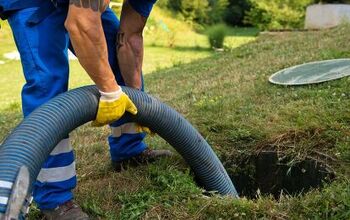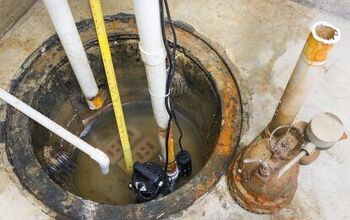How Much Does It Cost To Pump A Septic Tank?

Believe it or not, many homeowners don’t realize they need to pump their septic tank regularly. Usually, the tank will back up throughout the house before anyone realizes what’s wrong. For those who live on land with a septic tank, the day will come where you need to pump it. How much will it cost you to do this?
The average cost to empty a septic tank is $398, but it costs $425 or more to pump a tank for a 3,000 square foot home. It costs $200 on average to pump a septic tank for RV or mobile home. Homeowners spend an average of $6,250 to replace a septic tank.
In this guide, we will discuss all the cost aspects of pumping a septic tank. It’s better to know the price beforehand, so you’re not caught off guard if it ever happens to you.
Do You Need a Septic Tank Cleaning or Pumping Service?
Get free, zero-commitment quotes from pro contractors near you.

Septic Tank Pumping Cost
Average Cost To Pump Septic Tank | |||
Low | Typical Range | Average | High |
$200 | $285 – $529 | $398 | $1,000 |
The average cost to pump or clean a septic tank is about $398. However, most people will find themselves spending between $285 and $529. If you have a large tank, it may even cost you $1,000 or more.
Most homes between 1,500 and 3,000 square feet pay between $250 and $600. Homeowners need to know that tanks usually need pumping every 3 to 5 years. They should also receive an inspection every 1 to 3 years.
How Often Do You Need To Pump A Septic Tank?
Septic Tank Cleaning Frequency | ||
People | Tank Size (Gallons) | Frequency (Years) |
1 Person Only | 750 – 1,000 | 12-Sep |
2 to 3 | 900 – 1,250 | 3.5 – 8 |
4 to 5 | 1,000 – 1,500 | 4-Feb |
There are two main factors when it comes to how often you should pump your septic tank:
- How big is your tank?
- How many people use that tank frequently?
Most of the time, you will want to pump your septic tank every 3 to 5 years. However, if you only have one to two people using it, you may not have to pump it for 20 years. It all depends on these two factors.
Septic Tank Pumping Cost Near You
Septic Pumping Prices By City | |
City/State | Price |
Little Rock, AR | $260 – $510 |
Phoenix, AZ | $360 – $600 |
Denver, CO | $260 – $350 |
Jacksonville, FL | $245 – $435 |
Boise, ID | $250 – $440 |
Minneapolis, MN | $175 -$275 |
Concord, NH | $255 – $330 |
Long Island, NY | $275 – $515 |
Portland, OR | $440 – $750 |
Milwaukee, Wi | $245 – $320 |
Septic Tank Pumping Price By Size
Septic Pumping Prices By Size | |
Size (Gallons) | Price |
600 – 700 | $175 – $300 |
800 – 1,000 | $225 – $400 |
1,250 – 1,500 | $275 – $500 |
1,750 – 2,000+ | $325 – 600+ |
Cost To Empty A Septic Tank
The only times you’ll ever need to empty your septic tank are when you’re:
- Removing it
- Moving the tank
- Replacing it
Emptying a septic tank doesn’t guarantee that all of the waste will be removed. When someone empties it, it means that most of the sludge is removed.
The cost to empty a septic tank is the same as pumping it. You can expect to pay between $200 and $500. However, if you’re replacing the whole tank, you will pay $3,000 to $9,500, which includes the emptying of the tank.
RV Septic Tank Cleaning Cost
If you are emptying the septic from an RV, expect to pay between $150 and $250. The septic tank on an RV is called a holding tank, and they aren’t very big. You will need to pump these a lot more frequently than a standard septic tank.
Since the waste is dumped at an RV disposal site, emptying is usually free. Although, you will want to spend the extra money to thoroughly clean the tank before you store the RV for the winter.
Septic Tank Cleaning Cost
After you are done pumping, you will need to spend between $100 to $800 in order to clean the tank. Although, for large commercial systems, this price will be significantly more. Pumping the septic tank removes the sewage. When you clean the tank, this eliminates the tank’s solid elements, some of the filters, and the pipes.
Cleaning Methods
The two main cleaning methods for a septic tank include the following:
- Jetting: The removal of buildup from within the pipes
- Pumping: Removal of sewage from the septic tank
Most of the septic tank repairs cost between $500 and $2,500. These are usually costs that come from a lack of maintenance. This is why it’s so essential for you to clean the filters, pump your tank, and inspect your system on a regular basis.
Septic Tanks Care And Maintenance Cost
Septic tank maintenance extends far beyond pumping every 3 to 5 years. In fact, you will spend anywhere from $100 to $1,000 and higher every few years on maintenance costs. This includes the cleaning of the tank and the chemicals and enzymes you may use to put into the holding tank, depending on the type.
Monthly Septic Tank Treatment
It’s estimated that more than 20 million homeowners in the USA use a septic tank to treat their wastewater. This is especially true in rural areas, since homes are not close enough to link to the public sewer lines. These homeowners are at risk of people selling them false chemicals for their septic tank.
Additives for the typical septic tank are not necessary. If your septic system is healthy, it will have everything that it needs to treat and get rid of the waste. In fact, the additives can be more harmful than beneficial to your drain field, surrounding groundwater, and the tank itself!
You will find yourself spending about $12 to $50 a month on monthly maintenance overall. Don’t fall for the scams of tank additives.
Additional Cost Factors
Whether you spend $400 every two or every five years will come down to how you maintain your leach field and your tank. Some of the factors you’ll want to consider and maybe even change include:
- Entertainment: If your home is where everyone gets together, expect to provide maintenance frequently
- Coffee grounds: Do not flush the grounds down the sink.
- Grease: Never put grease down the drain. This will clog the drain, and eventually clog the septic as well.
- Garbage Disposal: You could begin recycling and composting instead of using your garbage disposal.
- Buildings: Don’t place structures of any size on a leach field, whether it’s temporary or permanent.
- Laundry: Don’t do back to back loads. You can also divert your laundry water into a separate system, and avoid using powdered laundry soap.
- Parking: Don’t put cars on your leach field. Eventually, the soil will compress.
Aerobic Septic System Maintenance Cost
For an aerobic septic system, you will need to add bacteria to your tank; this will cost between $50 and $500. The price will heavily depend on the size and type of your tank, as well as if any prep work is needed.
However, most homeowners will fall within the range of $100 to $200. Although, you might pay less if you combine the prep work with the pumping.
Septic System Inspection Cost
To get the septic tank inspected, it will cost you between $100 and $900 for visual inspection only. If you want a professional to put a camera into the lines, that will add about $250 to $900 to the price. It’s recommended to only opt for a camera inspection if your drains are slow and the problem isn’t diagnosed.
Septic Tank Inspection Cost | |
Type Of Inspection | Price |
Initial Inspection | $250 – $500 |
Annual Inspection | $100 – $150 |
Camera Inspection | $250 – $900 |
What Is The Cost Difference Between The Sewer And Septic Tank?
While people tend to focus on the expenses of managing a septic tank, no one talks about the high cost for municipal sewer systems. Homeowners are sometimes charged hefty fees for the installation and repair work on a newer sewage system.
Many different communities impose “sewer betterment fees.” These fees easily reach into five figures at times. In Massachusetts, one small town had a betterment fee of a whopping $16,000!
Septic vs. Cesspool: What Is The Difference?
The differences between a septic tank and a cesspool lie with how they function to get rid of the waste. Although, the cost to pump a septic tank and cesspool is the same. A septic tank system functions the same as a cesspool does. Although, it’s separated by two components, which are the tank and the drain field.
The tank allows the wastewater into it. It then only lets the greywater go through to the drain field. The sludge remains inside of the tank. The drain field scatters the greywater over a larger area than a cesspool. This allows it to drain through the soil, which then decontaminates it.
The cesspool has perforated walls for lining, which the wastewater flows through and disperses into the soil. When the soil is saturated, you then need to dig another cesspool. In most areas of the USA, cesspools have been banned, which is why most people have septic tanks.
DIY Septic Tank Pumping vs. Hiring A Professional
Pumping your septic tank isn’t a DIY project, unfortunately. The sludge pumped from the tank has to be stored in appropriate containers for transport. It also has to be disposed of in a particular way. When you are searching for a professional, ask them what the quote entails. Some specialists will include cleaning of the tank while others will charge an extra fee.
Do You Need a Septic Tank Cleaning or Pumping Service?
Get free, zero-commitment quotes from pro contractors near you.

Related Questions
How does a septic tank work?
Your septic tank is not on a sewer system. It is only used by any person who uses the facilities on your property. The septic tank will collect wastewater from your toilets, sinks, and showers. It divides the wastewater into scum, greywater, and sludge, which will all travel to its rightful place.
How do I know if my septic tank is full?
If your septic tank is full, you will notice smells coming from the drains in your home or from the outside area. You may also experience backed up sewage coming through your drains.
What happens if a septic tank is not pumped?
If you do not pump your tank regularly, you may experience some difficulties such as:
- Sludge buildup
- Clogged or broken pipes
- Clogged or broken tank
- Ruined drain field
This will cost you tens of thousands of dollars to fix in the case of anything breaking. It’s better to pump your tank every three to five years.

Heather is a passionate writer who loves anything DIY. Growing up, she learned everything from home repairs to design, and wants to share her tips with you. When she's not writing, she's usually hiking or searching for her next DIY project.
More by Heather Robbins













![How Much Does a Pool Pump Cost? [By Type & Installation]](https://cdn-fastly.upgradedhome.com/media/2023/07/31/9100804/how-much-does-a-pool-pump-cost-by-type-installation.jpg?size=350x220)





![How To Reset A Whirlpool Cabrio Washer [In 5 Easy Steps!]](https://cdn-fastly.upgradedhome.com/media/2023/07/31/9076531/how-to-reset-a-whirlpool-cabrio-washer-in-5-easy-steps.jpg?size=350x220)







